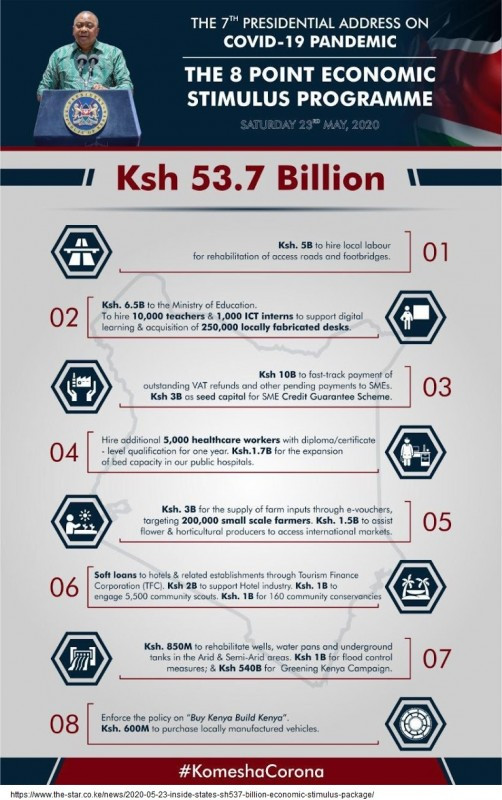Pick Up
48. New Coronavirus Pandemic - Reversing the Poverty Reduction Trend with COVID-19

On May 23, 2020, The Economist discussed how a new coronavirus infection (COVID-19) could reverse recent progress in reducing global poverty and cause the number of people living in poverty to soar. The number of people living in absolute poverty has declined from 2 billion or 36% of the world's population in 1990 to 630 million or 8% by last year. The World Bank estimates that at least 49 million people will fall into absolute poverty as a result of the lockdown and the collapse of the global economy, but this was a forecast as of April and recent figures suggest a much darker future. One estimate said that a 20 percent drop in global per capita income could last for at least several months, raising the number of people in absolute poverty to 4.2 million, the equivalent of the population of South America. While lockdowns in developed countries allow for remote work and tax-financed unemployment and absence compensation, the situation is different in poor countries. If you don't go to work, you don't have any income, and the decrease in income directly leads to food shortages. The World Food Program (WFP) predicts that acute hunger will double by the end of 2020.
According to a note published by the World Bank based on a comprehensive analysis of data from 45 of the 48 countries in Sub-Saharan Africa (How Much Will Poverty Rise in Sub-Saharan Africa in 2020?), pandemics will significantly reduce GDP per capita growth in 2020, exacerbating poverty. According to a note published by the World Bank (How Much Will Poverty Rise in Sub-Saharan Africa in 2020? The pre-crisis GDP per capita growth rate was estimated at 1.7%, but the pandemic is expected to reduce it by 5-7%, to 3.1% in the baseline and 5.5% in the worst case scenario. In sub-Saharan Africa, the number of people in absolute poverty, defined at $1.9 per day, is assumed to increase by an additional 26 to 58 million, and the poverty rate could rise by 2 percent, returning to 2015 levels and wiping out the progress made in reducing poverty over the past five years. Half of the new poor population will be concentrated in five countries: the Democratic Republic of Congo, Ethiopia, Kenya, Nigeria, and South Africa, with 6.9 million new poor in Nigeria in particular. Sao Tome and Principe, Zimbabwe, Niger, the Republic of Congo, Sierra Leone, and Botswana are expected to experience the largest increases in poverty.
In Kenya, the economy was initially expected to grow in 2020, but due to the lockdown and disruptions in the global supply chain, foreign currency earning sectors such as tourism, tea, flower and fruit exports have been hit and the growth rate is expected to drop significantly. On May 23, 2020, the President of Kenya announced a stimulus package of 537 million Kenyan shillings (1 Kenyan shilling = about 1 yen as of May 2020). The stimulus package includes job creation and investment in public policy, education (including ICT and digital learning) and health sectors, liquidity support measures such as tax exemptions for small and medium enterprises, and support for tourism workers and equipment maintenance and renewal. For agriculture, in addition to the ¥300 million support for inputs (fertilizer, seeds, etc.) through e-vouchers for 200,000 small-scale farmers, and ¥1.5 billion to support international market access for producers in the fruit and flower sector, the government will also support the renewal of water management facilities in arid and semi-arid areas to mitigate the impact of deforestation and climate change and conserve water resources. In addition to the 1.5 billion yen to support international market access for flower sector producers, the government also promised explicit budget allocations for water management facility upgrades in arid and semi-arid areas to mitigate deforestation and climate change impacts, and conserve water resources.
Incidentally, the Kenyan floriculture industry, which was devastated by the closure of the Dutch auction in March 2020, is gradually moving towards resumption of exports following the easing of the lockdown in Europe (Bloomberg May 22, 2020), Bloomberg May 22, 2020). Exports are back up to 60% capacity utilization, but it is also difficult to find enough space on aircraft (Pick Up 41), and cargo costs per kilogram remain high at $3.3 per kilogram compared to $1.5 last year. Kenya spent about $1 billion last year. Kenya exported about $1 billion worth of flowers last year, with auctions in the Netherlands accounting for half the sales. Auction operators in the Netherlands said revenues for the week of May 11 were down 6.9 percent from last year, a sign that the market is about to level off.
References
Bloomberg Kenya Plans $503 Million Economic Stimulus to Battle Virus By David Herbling May 20, 2020 https://www.bloomberg.com/news/articles/2020-05-19/kenya-plans-503-million-economic-stimulus-to-battle-virus
Bloomberg. Economics: Lockdown Easing in Europe Revives Kenyan Flower Industry By David Herbling May 22, 2020. https://www.bloomberg.com/news/articles/2020-05-22/lockdown-easing-in-europe-revives-kenyan-flower-industry
The Economist. The great reversal Covid-19 is undoing years of progress in curbing global poverty The number of very poor people was steadily falling; now it is rising fast, May 23, 2020. https://www.economist.com/international/2020/05/23/covid-19-is-undoing-years-of-progress-in-curbing-global-poverty?utm_campaign=coronavirus-special-edition&utm_medium=newsletter&utm_source=salesforce-marketing-cloud&utm_term=2020-05-23&utm_content=article-link-2
Montes, Jose; Silwal, Ani; Newhouse, David; Chen, Frances; Swindle, Rachel; Tian, Siwei. 2020. How Much Will Poverty Rise in Sub-Saharan Africa in 2020?. World Bank, Washington, DC. https://openknowledge.worldbank.org/handle/10986/33765
STAR. CUSHION FROM COVID-19 EFFECTS Inside state's Sh53.7 billion economic stimulus package. May 23, 2020. https://www.the-star.co.ke/news/2020-05-23-inside-states-sh537-billion-economic-stimulus-package/
Pick UP 15. New Coronavirus Pandemic ― Impact on World Trade and Developing Countries Dependent on Commodity Crop Export https://www.jircas.go.jp/en/program/program_d/blog/20200412
Pick Up 41. Global Supply Chain of Fruits and Vegetables Under Lockdown https://www.jircas.go.jp/en/program/program_d/blog/20200615_1
Contributor: IIYAMA Miyuki (Research Strategy Office)
